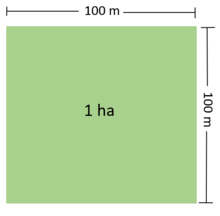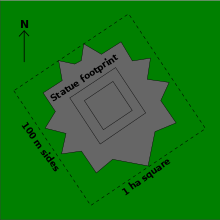| Hectare | |
|---|---|

Visualization of one hectare
| |
| General information | |
| Unit system | Non-SI unit accepted for use with SI |
| Unit of | Area |
| Symbol | ha |
| In SI base units: | 1 ha = 104 m2 |
The hectare (/ˈhɛktɛər,
In 1795, when the metric system was introduced, the "are" was defined as 100 square metres and the hectare ("hecto-" + "are") was thus 100 "ares" or 1⁄100 km2 (10,000 square metres). When the metric system was further rationalised in 1960, resulting in the International System of Units (SI), the are was not included as a recognised unit. The hectare, however, remains as a non-SI unit accepted for use with the SI units, mentioned in Section 4.1 of the SI Brochure as a unit whose use is "expected to continue indefinitely".
The name was coined in French, from the Latin ārea.
| Unit | SI |
|---|---|
| 1 ca | 1 m2 |
| 1 a | 100 m2 |
| 1 ha | 10,000 m2 |
| 100 ha | 1,000,000 m2 1 km2 |
| non-SI comparisons | |
| non-SI | metric |
| 0.3861 sq mi | 1 km2 |
| 2.471 acre | 1 ha |
| 107,639 sq ft | 1 ha |
| 1 sq mi | 259.0 ha |
| 1 acre | 0.4047 ha |
History
The metric system of measurement was first given a legal basis in 1795 by the French Revolutionary government. The law of 18 Germinal, Year III (7 April 1795) defined five units of measure:
- The metre for length
- The are (100 m2) for area [of land]
- The stère (1 m3) for volume of stacked firewood
- The litre (1 dm3) for volumes of liquid
- The gram for mass
In 1960, when the metric system was updated as the International System of Units (SI), the are did not receive international recognition. The International Committee for Weights and Measures (CIPM) makes no mention of the are
in the current (2006) definition of the SI, but classifies the hectare
as a "Non-SI unit accepted for use with the International System of
Units".
In 1972, the European Economic Community (EEC) passed directive 71/354/EEC,
which catalogued the units of measure that might be used within the
Community. The units that were catalogued replicated the
recommendations of the CGPM, supplemented by a few other units including
the are (and implicitly the hectare) whose use was limited to the measurement of land.
Units
Definition of a hectare and of an are
The names centiare, deciare, decare and hectare are derived by adding the standard metric prefixes to the original base unit of area, the are.
Centiare
The centiare is one square metre.
Deciare
The deciare is ten square metres.
Are
The are (/ɑːr/ or /ɛər/) is a unit of area, equal to 100 square metres (10 m × 10 m), used for measuring land area. It was defined by older forms of the metric system, but is now outside the modern International System of Units (SI).
It is still commonly used in colloquial speech to measure real estate,
in particular in Indonesia, India, and in various European countries.
In Russian and other languages of the former Soviet Union, the are is called sotka (Russian: сотка: 'a hundred', i.e. 100 m2 or 1⁄100 hectare). It is used to describe the size of suburban dacha or allotment garden plots or small city parks where the hectare would be too large.
Decare
The decare (/ˈdɛkɑːr,
- Stremma in Greece
- Dunam, dunum, donum, or dönüm in Israel, Palestine, Jordan, Lebanon, Syria and Turkey
- Mål is sometimes used for decare in Norway, from the old measure of about the same area.
Hectare
Trafalgar Square has an area of about one hectare.
The hectare (/ˈhɛktɛər,
Some countries that underwent a general conversion from traditional measurements to metric
measurements (e.g. Canada) required a resurvey when units of measure in
legal descriptions relating to land were converted to metric units.
Others, such as South Africa, published conversion factors which were
to be used particularly "when preparing consolidation diagrams by
compilation".
In many countries, metrication redefined or clarified existing
measures in terms of metric units. The following legacy units of area
have been redefined as being equal to one hectare:
- Jerib in Iran
- Djerib in Turkey
- Gong Qing (公頃/公顷 – gōngqǐng) in Hong Kong / mainland China
- Manzana in Argentina
- Bunder in The Netherlands (until 1937)
Conversions
| Metric equivalents | Imperial/US customary equivalents | ||||
|---|---|---|---|---|---|
| centiare | ca |
|
1 m2 | 0.01 a | 1.19599 sq yd |
| are | a | 100 ca | 100 m2 | 0.01 ha | 3.95369 perches |
| decare | daa | 10 a | 1,000 m2 | 0.1 ha | 0.98842 roods |
| hectare | ha | 100 a | 10,000 m2 | 0.01 km2 | about 2.4710538 acres |
| square kilometre | km2 | 100 ha | 1,000,000 m2 |
|
0.38610 sq mi |
The most commonly used units are in bold.
One hectare is also equivalent to:
- 1 square hectometre
- 15 mǔ or 0.15 qǐng
- 10 dunam or dönüm (Middle East)
- 10 stremmata (Greece)
- 6.25 rai (Thailand)
- ≈ 1.008 chō (Japan)
- ≈ 2.381 feddan (Egypt)
Visualising a hectare
International rugby pitch
Waikato Stadium – Hamilton, New Zealand
The maximum playing area of an international-sized rugby union pitch is about one hectare.
On an international rugby union
field the goal lines are up to 100 metres apart. Behind the goal line
is the in-goal area (which is also a playing area). This area extends
between 10 and 22 metres behind the goal line, giving a maximum length
of 144 metres for the playing area. The maximum width of the pitch is
70 metres, giving a maximum playing area of 10,080 square metres or
1.008 hectares.
|
Statue of Liberty
The Statue of Liberty occupies a square of land with an area of one hectare.
The distance between the apex of the bastions
in the front of the base to those at the back (where the entrance to
the statue is located) is approximately 100 m while the distance between
the apices of the left-hand and right-hand bastions is a little under
100 m. Thus, if a square were to enscribe the bastions, it would have
sides of approximately 100 m, giving it an area of one hectare.
|
Interior of all-weather athletics track
Hansen Field at Western Illinois University in Macomb, Illinois incorporates an all-weather running track.
The grass in the centre of a standard athletic track is a little over one hectare in extent.
Athletics tracks are found in almost every country of the world.
Although many tracks consist of markings on a field of suitable size,
where funds permit, specialist all-weather tracks have a rubberized
artificial running surface with a grass interior (as shown in the
picture and diagram). The perimeter of the inside kerb of the track is a
little under 400 metres, as the actual length of the track is measured
300 mm from the inside kerb.
The IAAF specifications state that the radius of the kerb is 36.5 m,
from which it can be calculated that the area inside the kerb is
1.035 ha.
The socc







